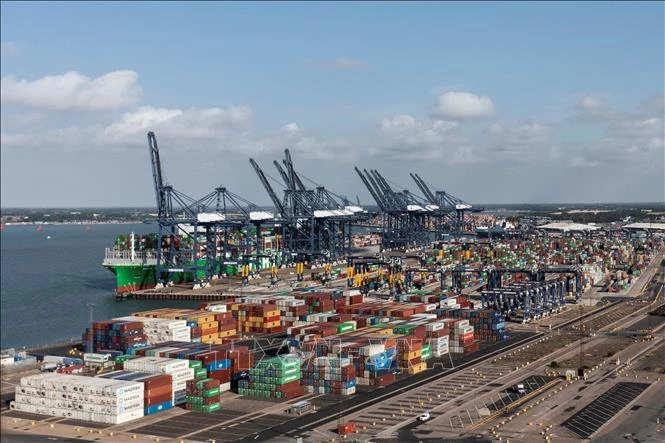DNVN - On October 22, the International Monetary Fund (IMF) adjusted its growth forecast for a number of economies in 2024, while warning of risks from armed conflicts, potential trade disputes, and the impact of tightening monetary policies.
In its newly released World Economic Outlook report, the IMF maintained its forecast for global economic growth this year at 3.2%, the same as its forecast in July. However, for 2025, the IMF forecasts global economic growth at only 3.2%, down 0.1 percentage points from its previous forecast. Over the medium term, growth is expected to average only 3.1% over the next five years, significantly lower than the trend before the COVID-19 pandemic.

View of the cargo port in Felixstowe, UK. Photo: AFP/TTXVN
The IMF has revised up its forecast for US GDP growth this year by 0.2 percentage points to 2.8%, largely due to better-than-expected consumption, boosted by rising wages and asset values. The forecast for US GDP growth in 2025 is also raised by 0.3 percentage points to 2.2%.
The IMF raised Brazil’s GDP growth forecast for 2024 by 0.9 percentage points to 3%, due to strong private consumption and investment. In contrast, the forecast for Mexico’s economic growth was cut by 0.7 percentage points to 1.5%, due to the impact of tight monetary policy.
The IMF cut its forecast for China’s economic growth this year by 0.2 percentage points to 4.8%, as rising net exports offset a weakening property sector and low consumer confidence. For 2025, China’s growth forecast remains at 4.5%, but does not include the impact of Beijing’s recently announced fiscal stimulus plans.
The IMF forecasts that Germany's economy will contract this year, down 0.2 percentage points from its previous forecast as the country's manufacturing sector continues to struggle. This will reduce Eurozone growth to 0.8% in 2024 and 1.2% in 2025, although Spain's economy is revised up by 0.5 percentage points to 2.9%.
India continues to be the strongest performer among major economies, with growth forecast at 7% in 2024 and 6.5% in 2025, unchanged from the July forecast.
The IMF also warned of risks that could threaten the economic growth outlook, including the possibility of a spike in oil and other commodity prices if conflicts in the Middle East and Ukraine escalate. The IMF also highlighted the risk of increased import tariffs and retaliation. If the US, the Eurozone and China impose 10% tariffs on each other, and the US increases tariffs by 10% on other countries, migration to the US and Europe would decline, while financial markets would be volatile. The IMF could revise down its global GDP forecast by 0.8% in 2025 and 1.3% in 2026. The agency also warned countries against pursuing protectionist policies for domestic industries and workers, as these policies often do not lead to sustainable improvements in living standards.
In some countries, monetary policy is likely to continue tightening without signs of interest rate cuts, even as inflation has fallen, putting pressure on growth and employment, IMF chief economist Pierre-Olivier Gourinchas said in an interview.
The IMF also highlighted in its latest report that the global transition to electric vehicles will have far-reaching impacts on investment, production, international trade and employment. The agency noted that the global auto industry has traditionally been characterized by high wages, good profits, large export markets and advanced technology. Accelerating the transition to electric vehicles would change this landscape, especially if China continues to maintain its manufacturing and export advantage over the US and Europe. In electric vehicle scenarios, Europe’s GDP is expected to decline by about 0.3% over the medium term. The number of auto industry jobs will decline and labor will gradually shift to less capital-intensive industries.
Cao Thong (t/h)
Source: https://doanhnghiepvn.vn/kinh-te/imf-dua-ra-du-bao-tang-truong-kinh-te-toan-cau-moi-canh-bao-mot-loat-nguy-co/20241023070457005









































































































Comment (0)